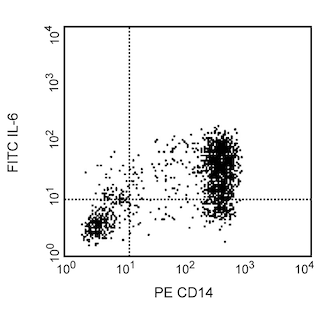Old Browser
This page has been recently translated and is available in French now.
Looks like you're visiting us from {countryName}.
Would you like to stay on the current country site or be switched to your country?


.png)

Detection of intracellular mouse IgG2a in an antibody-secreting hybridoma cell line. Cells were fixed, permeabilized, and stained with either the FITC anti-Mouse IgG2a mAb (Clone R19-15, filled histogram) or the matched FITC Rat IgG1, κ Isotype Control (Open histogram, Cat. No. 554684/553924). Flow cytometry was performed on a BD FACSCalibur™ flow cytometry system.
.png)

BD Pharmingen™ FITC Anti-Mouse IgG2a
.png)
Regulatory Status Legend
Any use of products other than the permitted use without the express written authorization of Becton, Dickinson and Company is strictly prohibited.
Preparation And Storage
Recommended Assay Procedures
R19-15 antibody is effective for detection of cell-surface or intracellular Ig by immunofluorescent staining with flow cytometric analysis. FITC-conjugated R19-15 mAb may be used as a primary or secondary reagent in immunofluorescent staining.
Product Notices
- Since applications vary, each investigator should titrate the reagent to obtain optimal results.
- Please refer to www.bdbiosciences.com/us/s/resources for technical protocols.
- Caution: Sodium azide yields highly toxic hydrazoic acid under acidic conditions. Dilute azide compounds in running water before discarding to avoid accumulation of potentially explosive deposits in plumbing.
- An isotype control should be used at the same concentration as the antibody of interest.
- For fluorochrome spectra and suitable instrument settings, please refer to our Multicolor Flow Cytometry web page at www.bdbiosciences.com/colors.
The R19-15 antibody recognizes an epitope in the CH3 domain of mouse IgG2a, with strong reactivity to the Igh-I[a] allotype and weaker reactivity to Igh-I[b]. It does not react with other Ig isotypes. Molecular genetic analyses suggest that the Igh-I[b] allele, which encodes IgG2a[b], is derived from a locus found in several wild mouse subspecies, but not domestic mice, which encodes the IgG2c isotype.

Development References (2)
-
Martin RM, Silva A, Lew AM. The Igh-1 sequence of the non-obese diabetic (NOD) mouse assigns it to the IgG2c isotype. Immunogenetics. 1997; 46(2):167-168. (Biology). View Reference
-
Morgado MG, Cam P, Gris-Liebe C, Cazenave PA, Jouvin-Marche E. Further evidence that BALB/c and C57BL/6 gamma 2a genes originate from two distinct isotypes. EMBO J. 1989; 8(11):3245-3251. (Biology). View Reference
Please refer to Support Documents for Quality Certificates
Global - Refer to manufacturer's instructions for use and related User Manuals and Technical data sheets before using this products as described
Comparisons, where applicable, are made against older BD Technology, manual methods or are general performance claims. Comparisons are not made against non-BD technologies, unless otherwise noted.
For Research Use Only. Not for use in diagnostic or therapeutic procedures.
Report a Site Issue
This form is intended to help us improve our website experience. For other support, please visit our Contact Us page.
